Slow Fashion Tour in Kampala
Nachhaltig unterwegs in Ugandas Hauptstadt

© Susanne Barta
© Susanne Barta
Kampala, die Hauptstadt Ugandas, mit einer Slow-/Sustainable-Fashion-Tour kennenzulernen, kann ich nur empfehlen. Ich bin das erste Mal in Afrika, die ersten Tage waren überwältigend. Die Farben, die Gerüche, der Staub (es regnet zu dieser Zeit kaum), das Gewusel an Menschen, die Dichte von Klein- und Kleinstgeschäften und diversen Gefährten, der herumliegende Plastikmüll, die anderen Lebensverhältnisse, die Ruhe und Freundlichkeit der Menschen, das gute Essen … Es bleibt kaum Zeit, all die Bilder und Erfahrungen zu verarbeiten, weil sich schon die nächsten daran reihen.
Pünktlich um 7:45 kommen Katende Godfrey und Nsubunga Saul (hier wird der Nachname vor dem Vornamen genannt) mit einem Safari-Jeep zu uns in Hotel. Godfrey ist Fashion Designer und Country Coordinator von Fashion Revolution Uganda, Saul sein Social Media Manager und engagierter Breakdancer. Nicht rechtzeitig fertig sind die noch etwas im Umstellungsprozess verlorenen Europäer. Dass Zeit flexibel ist und alles sehr entspannt und mit unendlicher Geduld abläuft, lerne ich gleich am ersten Tag. Die Wege sind meist lang, die Staus in der Stadt eine Dauersituation.
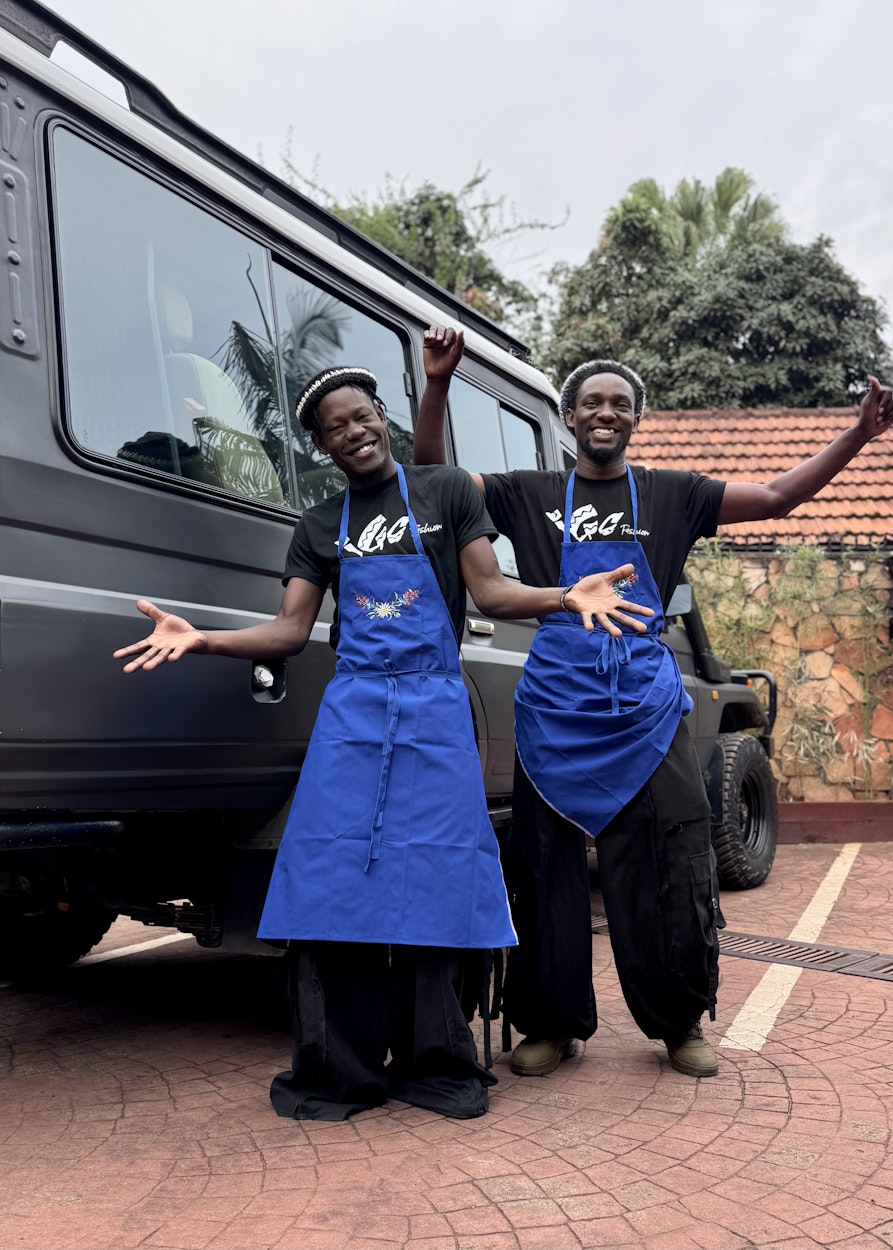
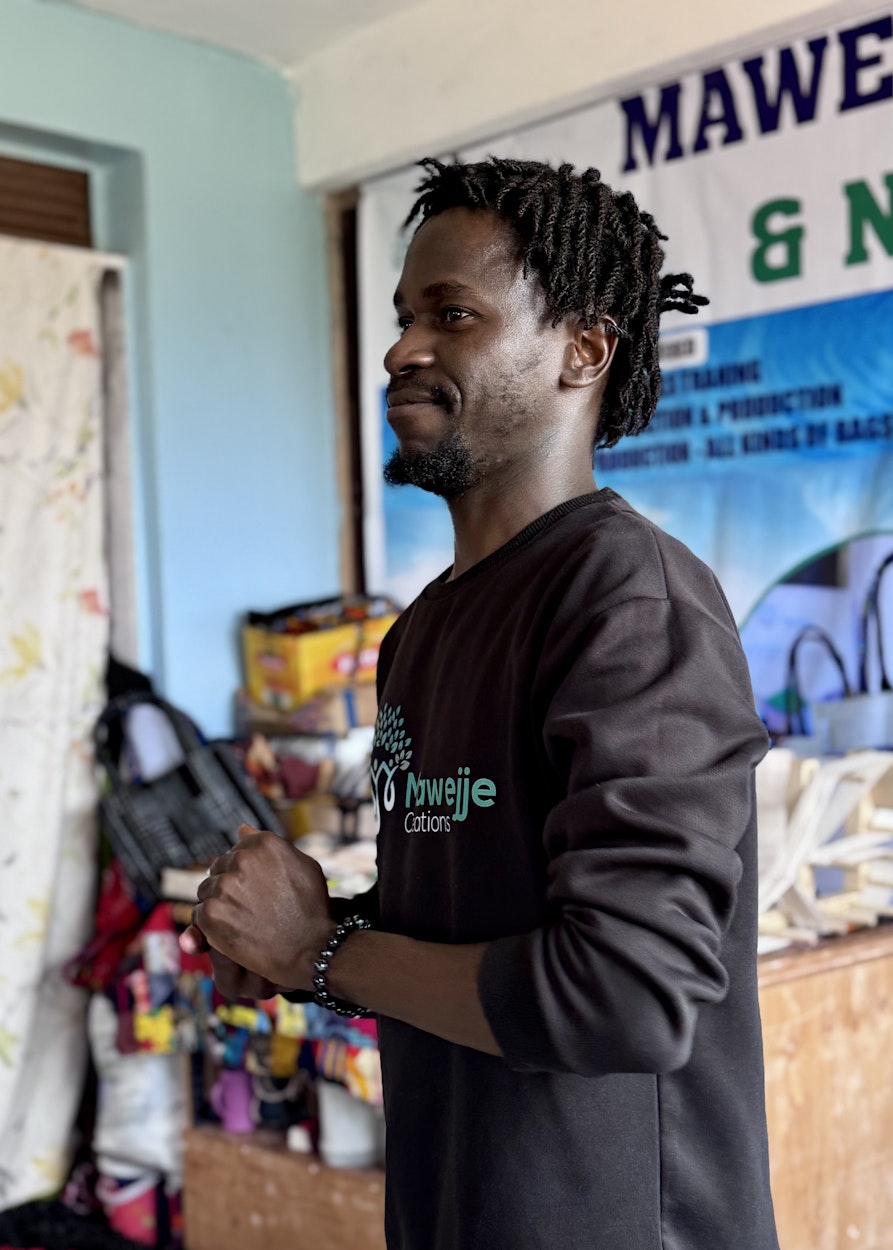
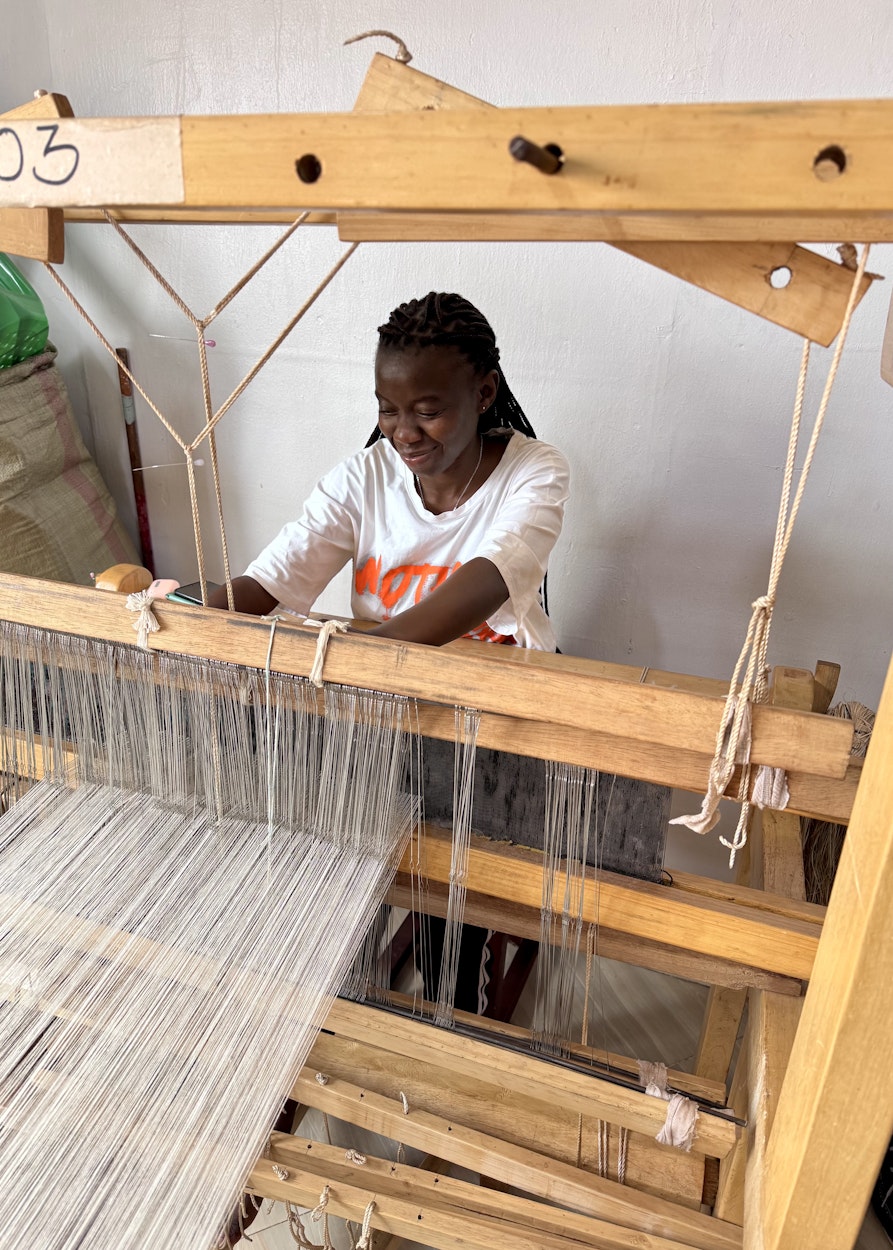
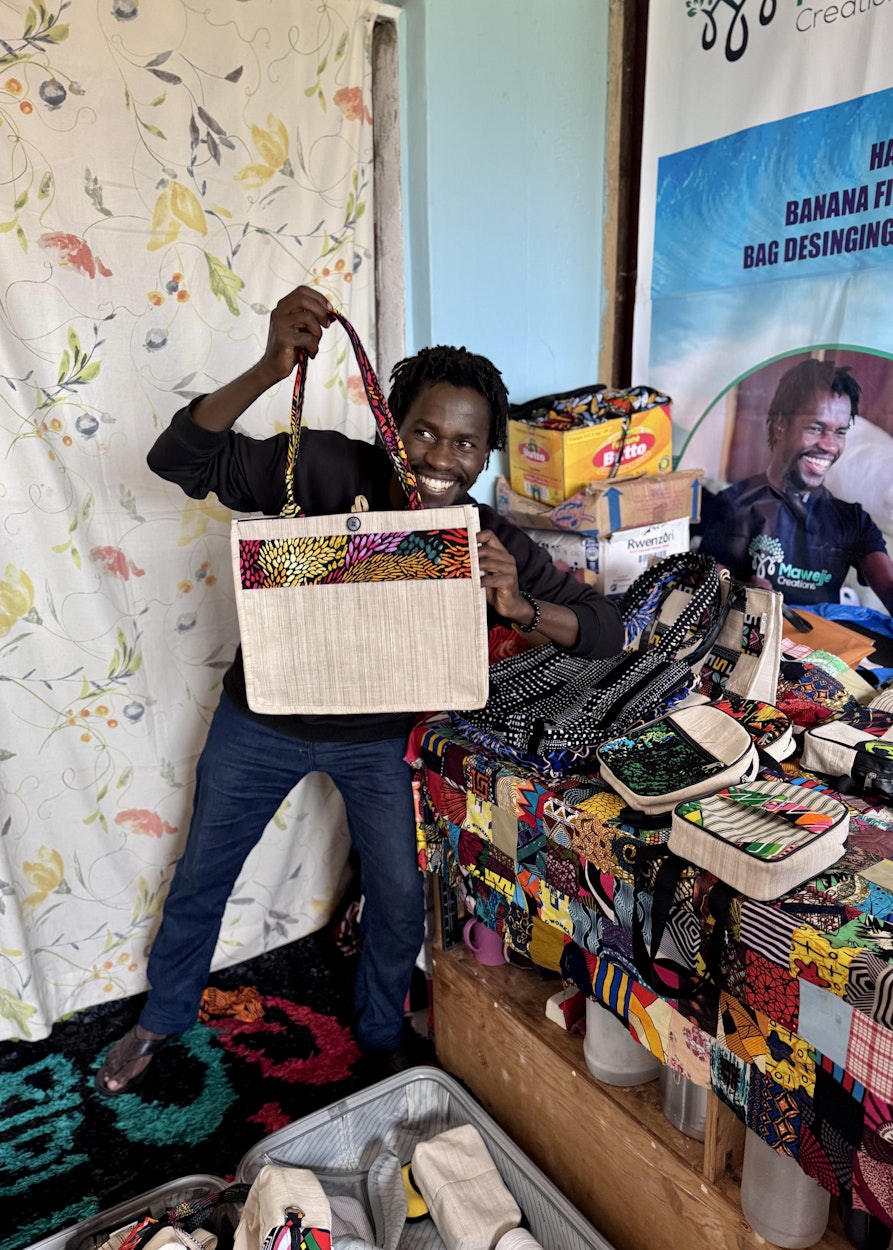
Auf dem Weg zur Führung über Barkcloth, ein traditionelles Material, das aus der Baumrinde des Mutuba-Baums (Ficus natalensis) gewonnen wird, schauen wir einen Sprung bei Godfreys Studio vorbei. Kleiderständer mit Entwürfen und fertigen Teilen, eine Nähmaschine und viele Plakate und Arbeitsutensilien an der Wand empfangen uns. Schon beim Kennenlernen in der Früh ist mir die coole Hose von Godfrey und Saul aufgefallen, am Ende unseres Besuchs lasse ich Maßnehmen und bestelle eine. Godfrey arbeitet mit Reststoffen und Secondhand-Teilen, er organisiert Community-Events und ist die zentrale Figur von Fashion Revolution Uganda. Er erzählt mir, dass ihm vor einigen Jahren eine ausländische Journalistin, der er seine Arbeitsweise erklärte, gesagt habe, dass das, was er und auch einige andere hier machten, sehr nachhaltig sei und dass es hilfreich sein könnte, sich in ein internationales Netzwerk einzuklinken. Das Konzept von nachhaltiger Mode, von Slow Fashion nimmt seitdem immer mehr an Fahrt auf, vor allem in Kampala. Über Godfreys Arbeit gibt’s bald einen eigenen Artikel.
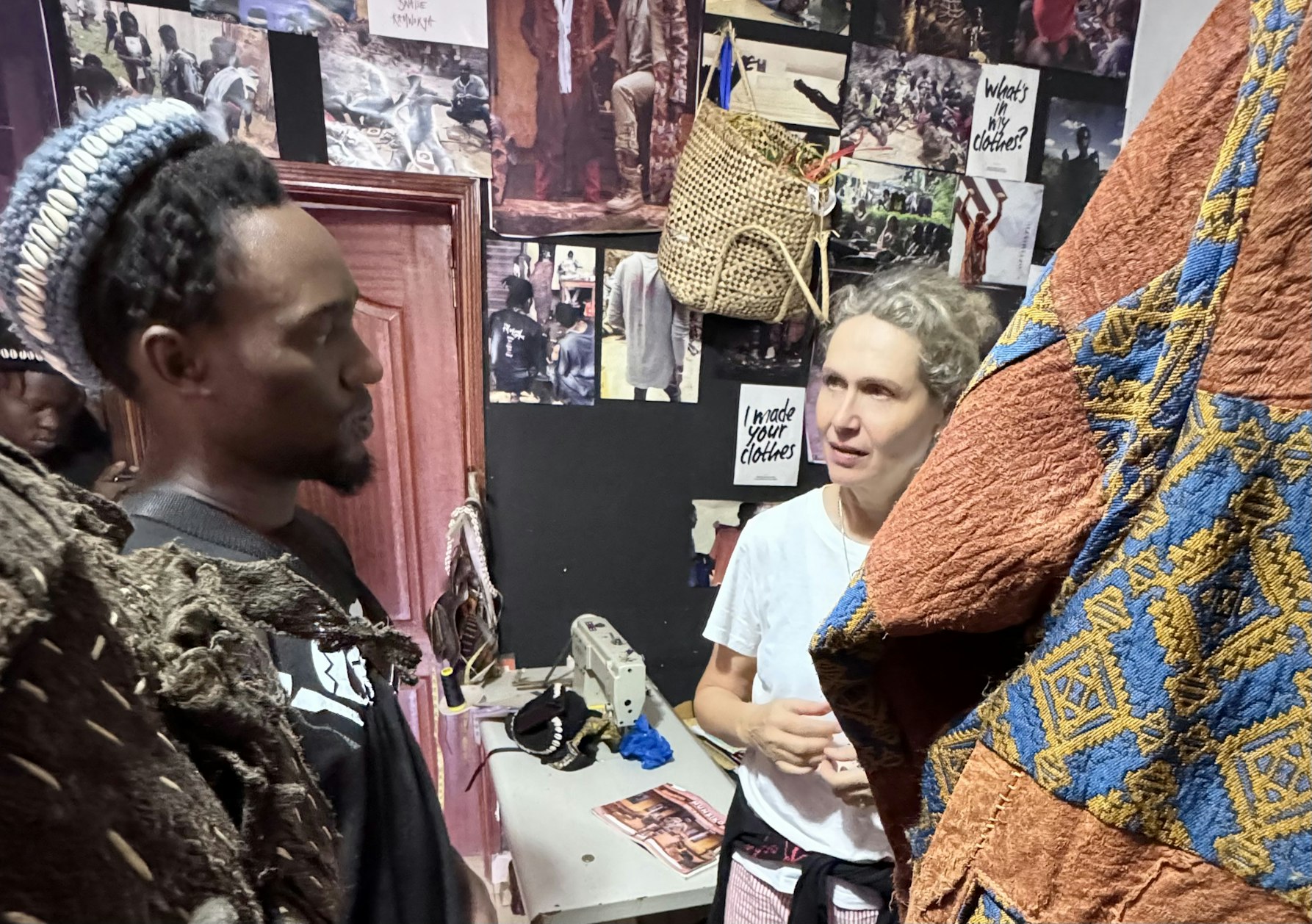
Die Führung mit Elvis, unserem Guide im Garten des Königspalastes, ist sehr spannend. Barkcloth wird, wie gesagt, aus einer bestimmten Baumrinde gewonnen. Die Herstellung verläuft in etwa so: die Baumrinde wird von Hand entfernt, die verletzte Stelle dann mit einem Bananenblatt geschützt, dass sich der Baum regenerieren kann, dann wird die Rinde, eingewickelt in ein Bananenblatt, gekocht, anschließend getrocknet und viele Stunden gehämmert – je länger, desto feiner der Stoff. Das Material hat eine lange Tradition in Uganda, wird allerdings nicht so häufig verwendet. Das hat einen Grund: Die britischen Kolonialherren wollten aus Geschäftsgründen die Baumwolle etablieren und haben das lokale Material verleumdet, indem sie verbreiteten, dass es verflucht sei und Unglück bringe. Dieser Glaube hält sich leider bei vielen Menschen bis heute. Dennoch ist Barkcloth auf dem Vormarsch, es wird lokal produziert, ist nachhaltig und vielfältig einsetzbar. Die Technik, Barkcloth herzustellen, wurde in das UN-Weltkulturerbe aufgenommen. Auch in Europa, erzählt Elvis, komme das Material gut an. Hier ein Video zum Herstellungsprozess.

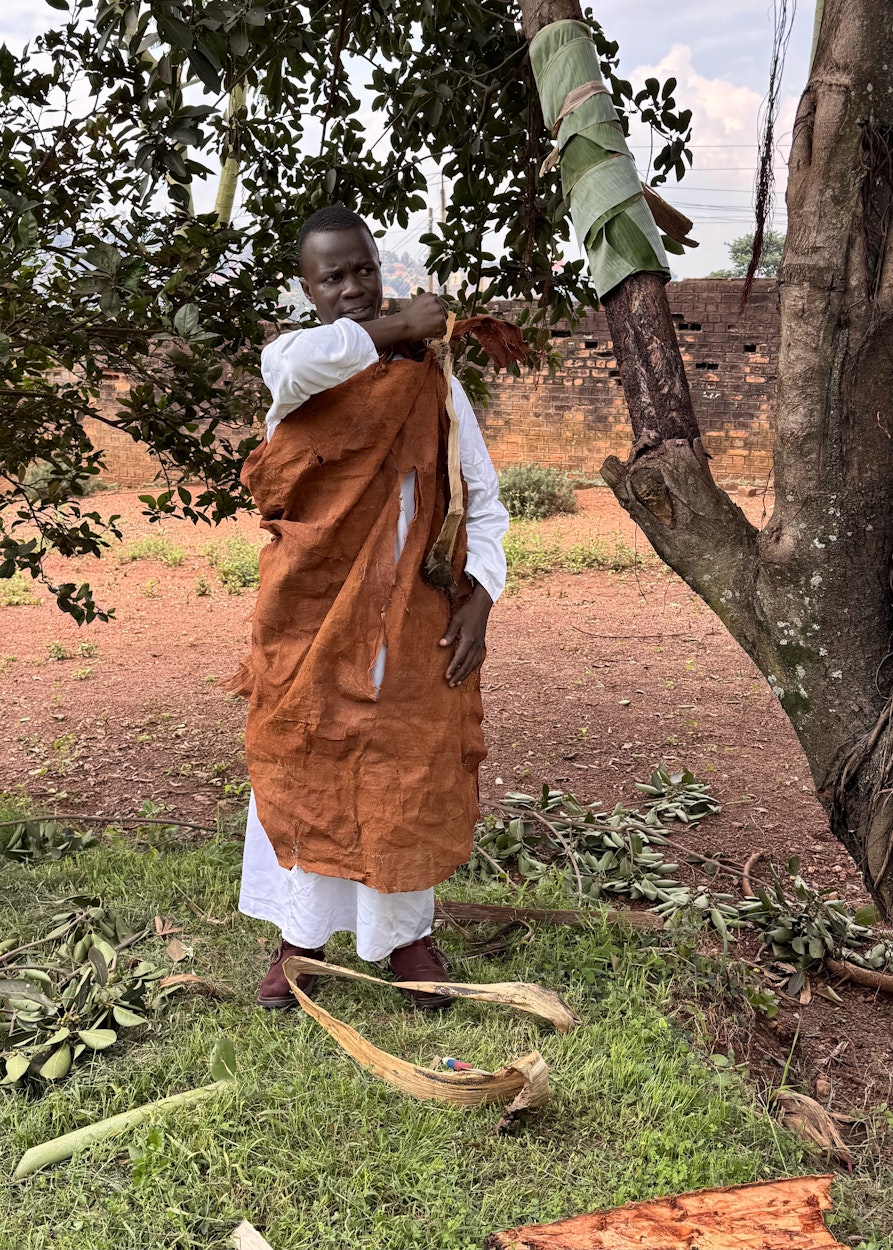
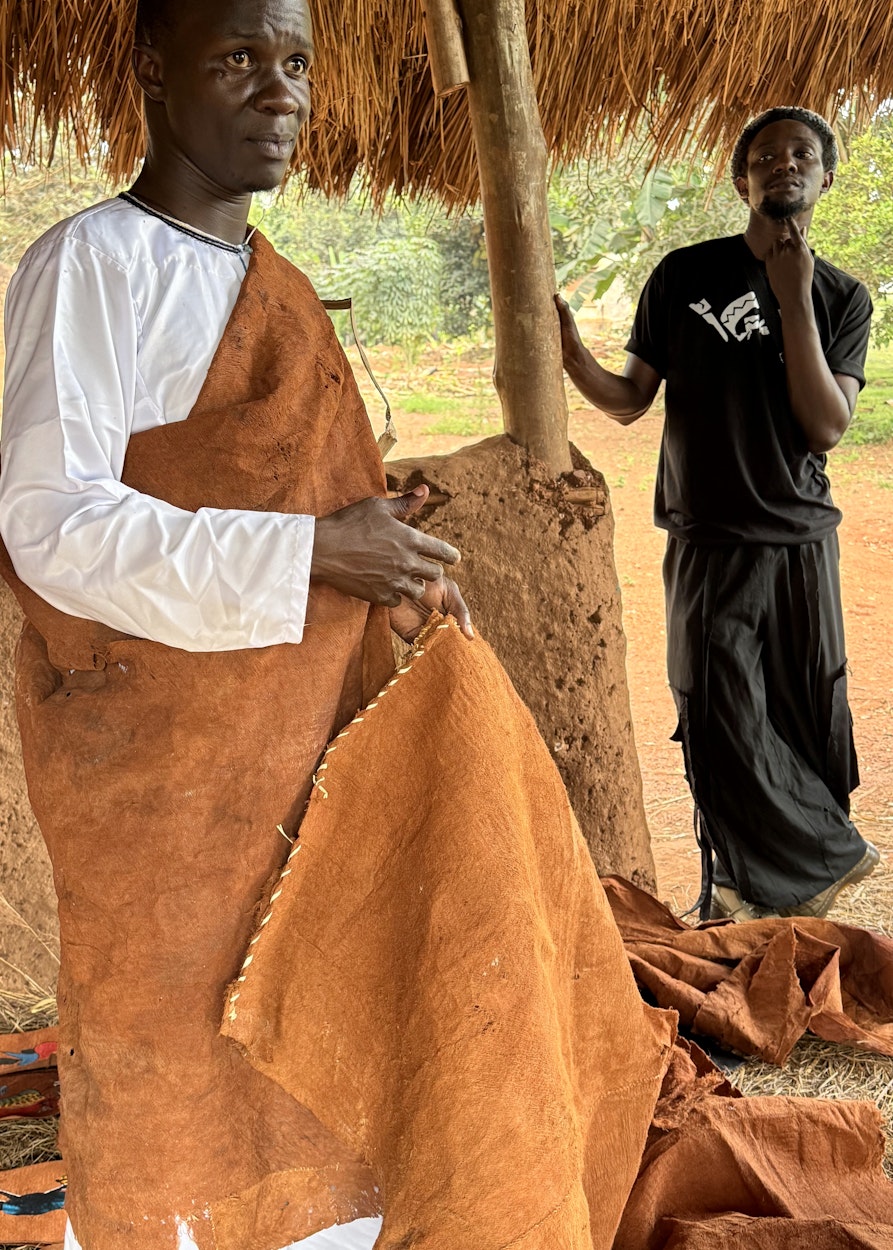
Zu guter Letzt haben wir den Owino Market besucht, er ist einer der größten Secondhand-Märkte in Zentralafrika. Unser Guide Miti hat uns zunächst aufgefordert, alle Schmuckstücke abzunehmen und die Tasche fest im Griff zu behalten. Der Markt ist riesig, die Verkäufer*innen sitzen dicht gedrängt und bieten ihre Ware an. Es gibt, gefühlt, alles. Hier alleine durchzugehen ist vermutlich nicht ratsam. „Secondhand clothes are donated from Europe and America and are meant to go to disadvantaged communities in rural areas of Africa. There are a lot of people who need these clothes, but the challenge is that they are not delivered there, but to the local markets. Yes, they provide jobs for local people, but they also kill the local fashion industry. There are too many secondhand clothes coming in and even tough local designers are working with these clothes, it can't be that they are doing that instead of creating our own textile industry”, sagt Miti. Er hat viel zu erzählen, die Zeit reicht leider nicht, um die vielen weiteren Geschichten zu hören. Aber ich hoffe, dass das nicht unser letzter Uganda-Besuch war.
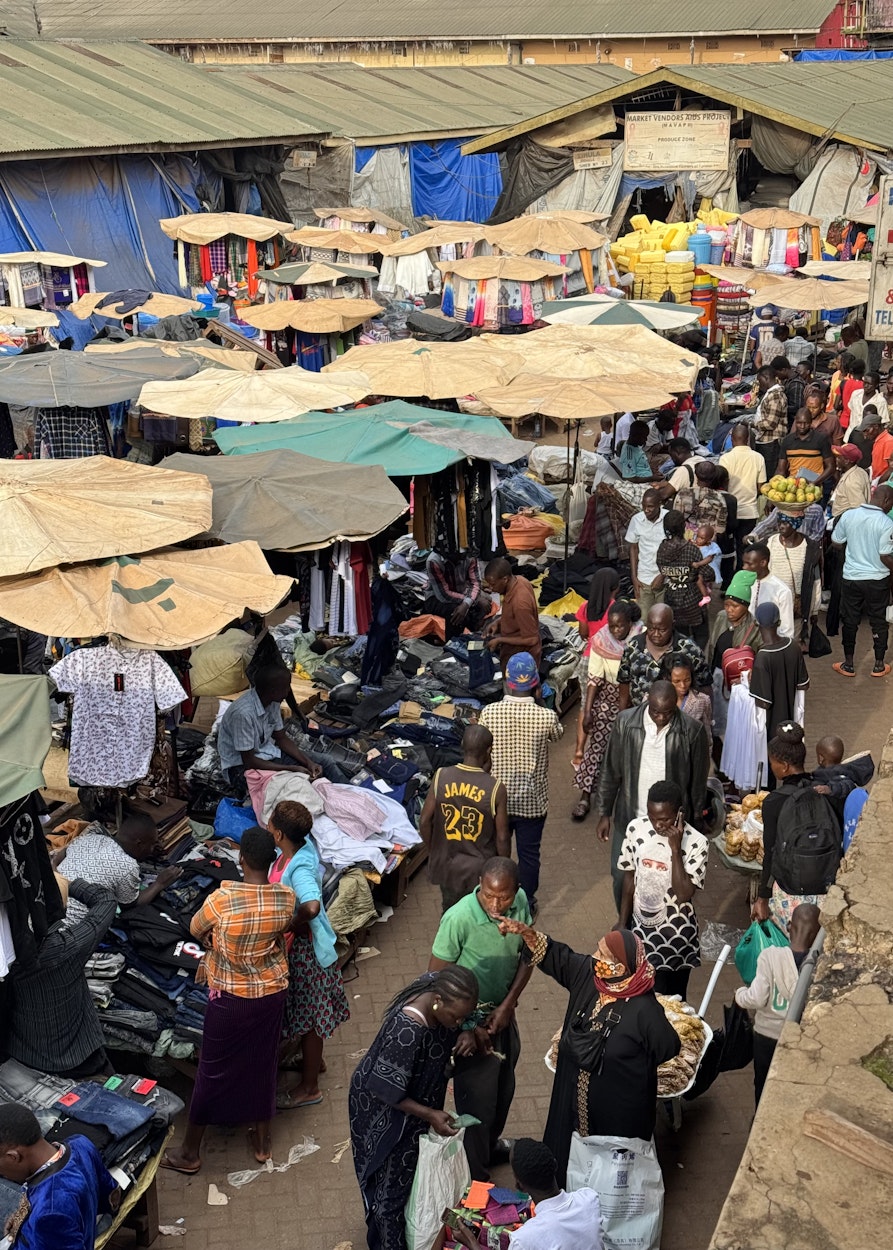
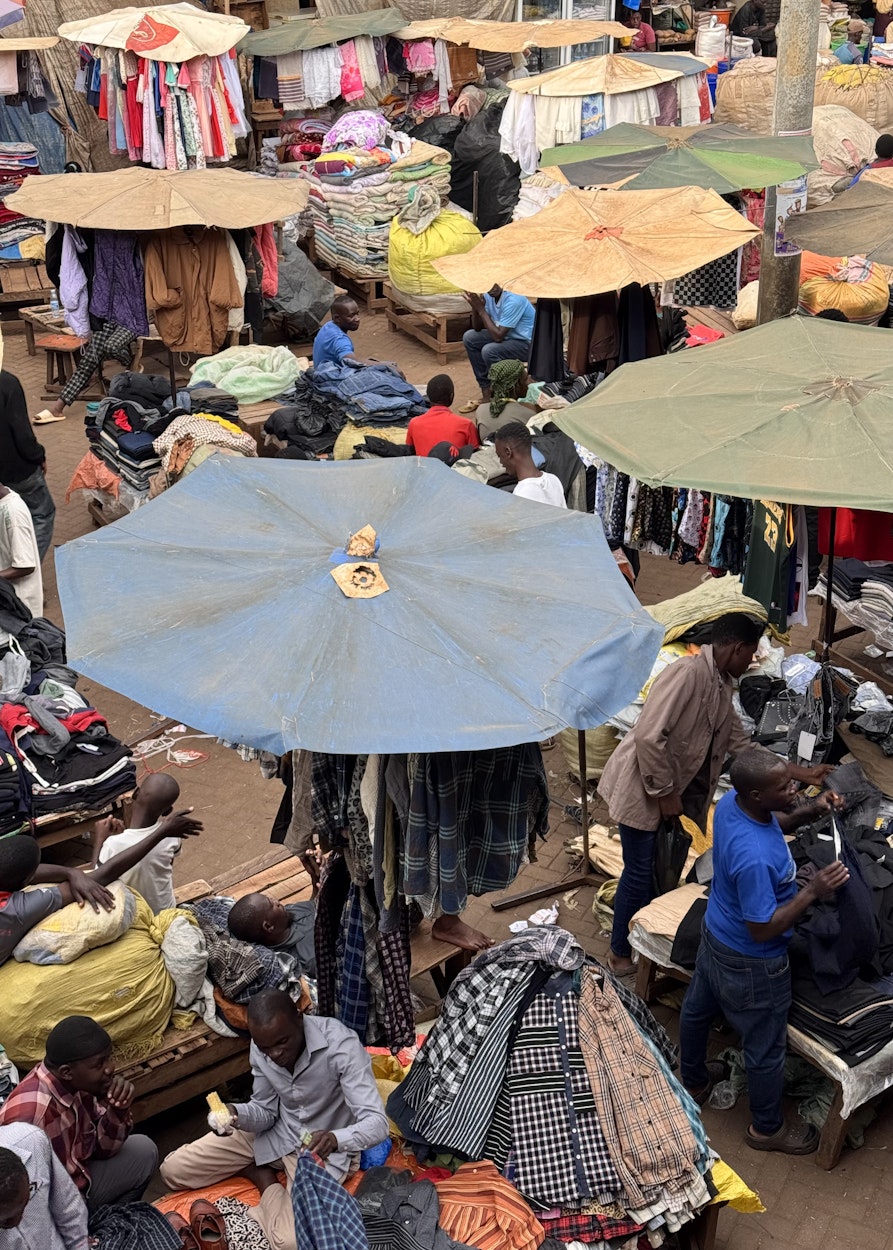
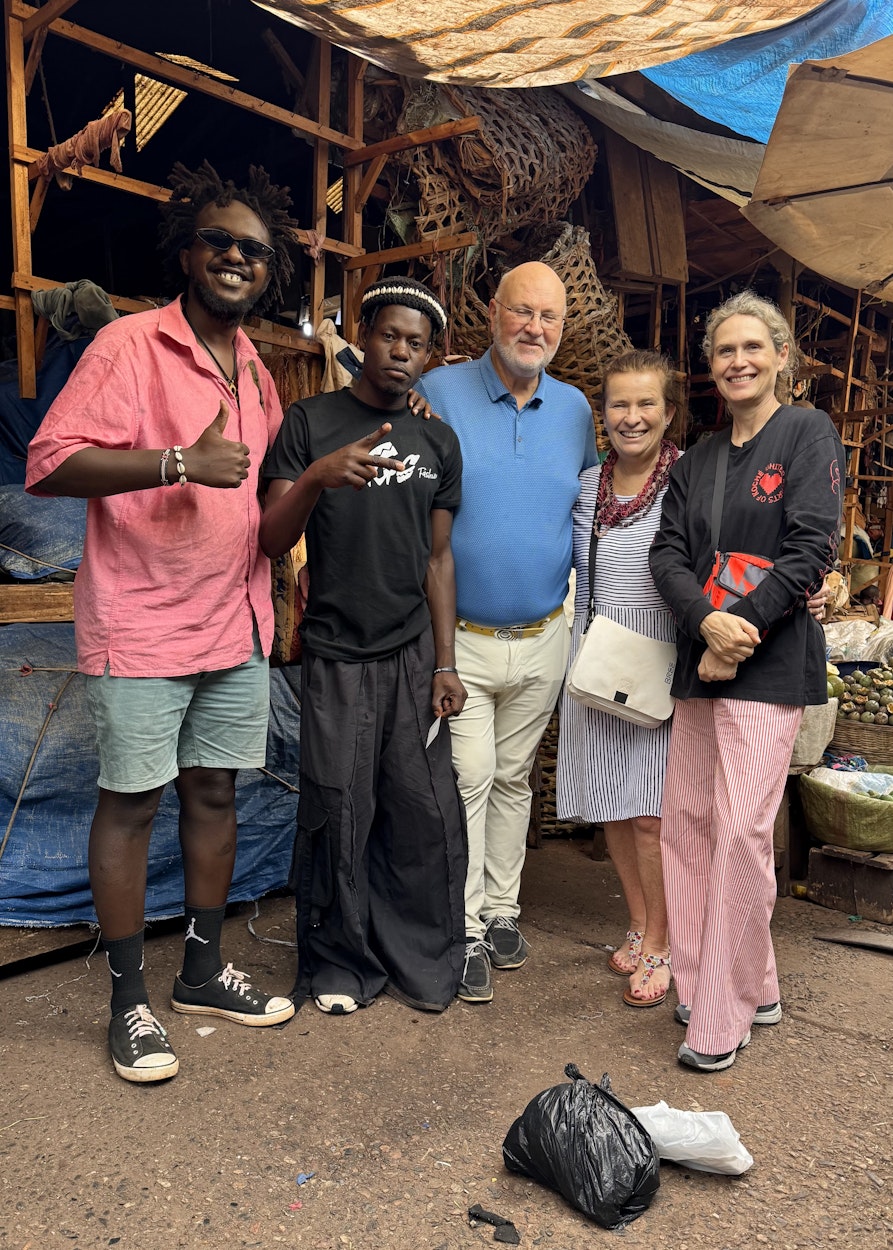
Auch ein kurzes Interview ging sich aus mit Godfrey über Fashion Revolution Uganda.
Godfrey, tell us about Fashion Revolution Uganda and what you are working on.
We are mainly working on empowering cultural values through fashion. We have a lot of local materials in our country that are not seen and that can contribute to solutions for materials that are harmful to the environment. One of our visions is for designers in our country to start using these materials. I am talking about organic materials like Rafia, Banana Fiber and Barkcloth. Another thing we are looking at is the secondhand garments coming into our country. We have a lot of secondhand clothes and one of the challenges is that many of them end up in landfills and pollute the environment. So, we are raising the conversation and encouraging designers and citizens to upcycle.
Chinese companies are very present in Uganda. I have read that they are also trying to flood the market in Africa with their super cheap fashion. Do you have a fast fashion problem in Uganda?
Yes, people buy cheap clothes and throw them away, and because they are cheap, they buy too much. Chinese companies copy many brands and sell them very cheaply. It's also a problem for the designers because instead of supporting local designers, people just go for the cheap, cheap stuff.
Your president Yoweri Museveni wanted to ban secondhand fashion coming in from the Global North. Did he actually do it?
No, he didn't. It's a tricky situation because a lot of people sell secondhand clothes and the clothes are coming in whether we like it or not, so it's better that people do something with them. When the president said he was going to ban it, they were afraid of losing their jobs.
But it would be better if we sent less?
One of the solutions we have thought about is to regulate what comes in, for example by improving the quality. At the moment we get a lot of clothes that are torn and stained. The vendors have to sort them and divide them into first, second and third class. The first class is more expensive, and then it's reduced and reduced, but the bad ones don't fit the market.
I heard in an interview with Bobby Kolade, the founder of Buzigahill, that African brands have to pay higher taxes when exporting to the Global North than our brands pay when exporting to Africa. Is your focus the Global North or your own continent?
One of the biggest challenges we have in our country, but also on the continent, is market access. Obviously, as a brand you want to expand, you want to sell not only to your people but to other people who see value in your brand. What happens at the moment is that we have to go through a lot of bureaucracy if I want to export my product and it is super expensive. Uganda is not a first world country and a lot of designers are struggling. They don't have the big money to make clothes in large quantities that you need to export. Personally, transport is my biggest challenge at the moment. If a customer from the UK or Europe buys from me, the transport could be twice the price of the garment. So I don't have many customers from there. Another challenge is materials. We don't have easy access to the quality that other designers have. For example, it is very difficult for me to access 100 % cotton in the country. It's not that we don't have cotton, we grow cotton, but it's not easy to buy it because it's all exported.
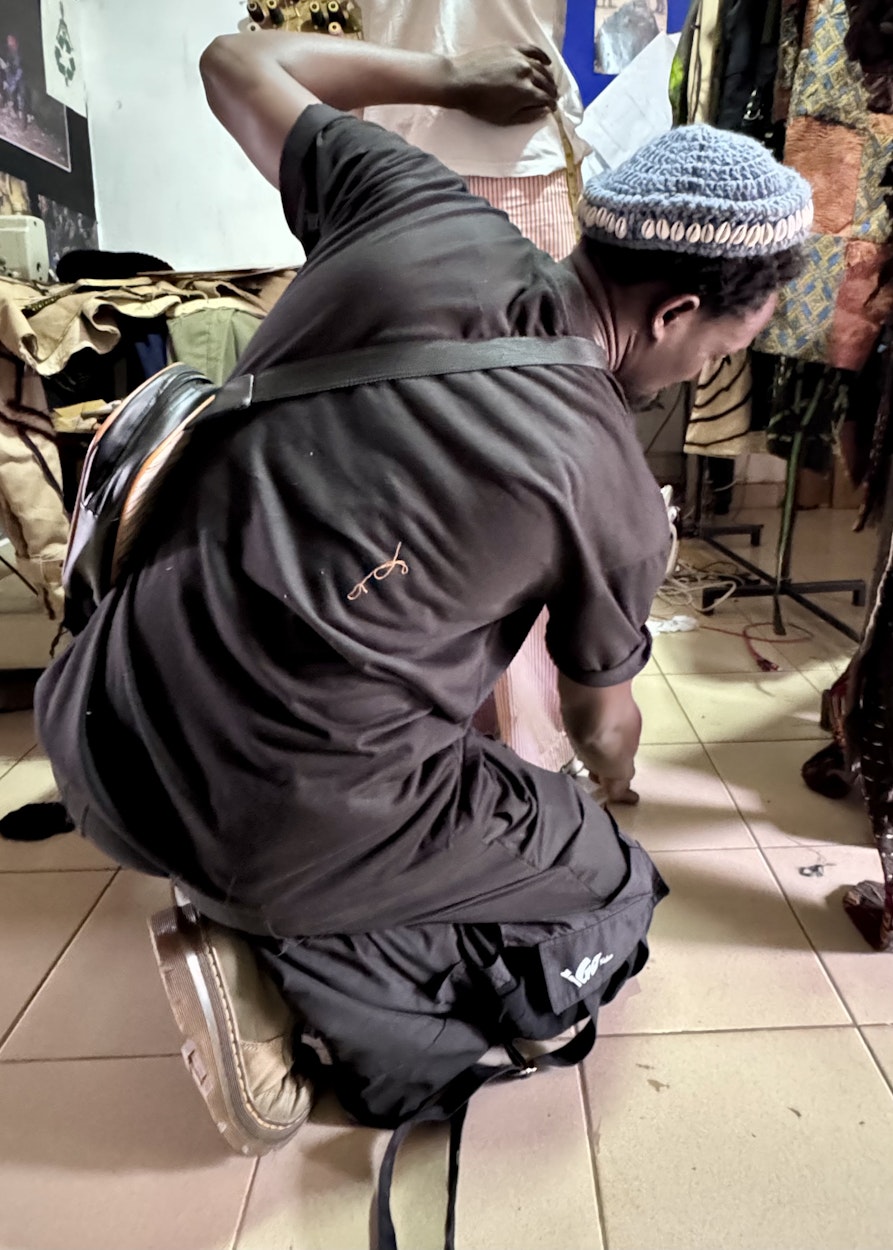
Ich hatte noch viele Fragen, aber die Zeit war knapp. Im Laufe der nächsten Wochen gibt’s einen eigenen Artikel über Godfreys Arbeit als Designer, ebenso einen über die Ecofashion Designerin Sharon Anena – ihr kennt sie bereits – und ihre Brand Ajura, bei deren Modenschau wir dabei waren. Und ich möchte euch einen visuellen Eindruck davon geben, wie individuell und inspirierend sich die Leute in Uganda kleiden. So, stay tuned.
Supported by Kauri Store (M), Oscalito (L) und meiner Freundin Kristin. Wenn ihr diesen Blog auch unterstützen möchtet, gibt’s hier alle Infos.